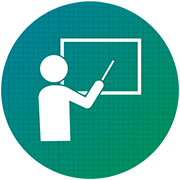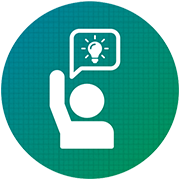The design of DTE modules
4 core elements
DTE modules are designed to support teachers in developing expertise in specific areas of elementary mathematics. Modules integrate four core elements of teacher professional learning.

Mathematical knowledge for teaching
Teachers need to develop "Mathematical Knowledge for Teaching" (MKT)—the mathematical knowledge, skills, and habits of mind that are inherent in the work of teaching. The level of a teacher’s MKT has a big effect on children’s mathematics learning (Hill, Rowan, & Ball, 2005).

Student thinking
Teaching involves skill in anticipating and interpreting students’ ideas and ways of thinking about mathematics. When professional development is grounded in explicit attention to student thinking, it has been shown to positively impact student learning (Fennema et al., 1996).

Teaching practices
Proficient teaching requires a repertoire of practices, routines, and techniques that enable teachers to effectively and efficiently help all students learn mathematics. Teachers benefit from direct work on these practices and the development of skill in parsing and describing their craft (Grossman & McDonald, 2008).

Learning from own practices
Developing teaching expertise is a career-long process. While teachers may serendipitously learn from their experiences, professional learning should not be left to chance. The idea that teachers need to learn more effectively from their day-to-day work has been consistently noted in research and educational theory (e.g. Dewey, 1916; Schön, 1983; Lampert, 2010) and, more generally, that the ability to critically examine one’s own change efforts over time is a key component to improvement (Bryk, Gomez, Grunow, Lemahieu, 2015).
These elements are integrated in various ways into each session. There are, for example, practice-based activities that engage teachers in analyzing videos of teaching and learning mathematics, discussing examples of student work, rehearsing a teaching practice in the company of colleagues, and analyzing and/or modifying activities, problems, and curriculum. Between PD sessions, teachers engage in Classroom Connection Activities that guide them in using PD content in their classrooms and bringing back insights or classroom artifacts for discussion in later sessions. This often involves the use of practice protocols—a clear sequence of actions and a set of core questions—that guide teachers’ self assessment and their collaborative work with colleagues to advance their learning.
References
Dewey, J. (1916). Democracy and education: An introduction to the philosophy of education. New York: Macmillan.
Fennema, E., Carpenter, T., Franke, M., Levi, L., Jacobs, V., & Empson, S. (1996). A Longitudinal Study of Learning to Use Children's Thinking in Mathematics Instruction. Journal for Research in Mathematics Education, 27(4), 403-434.
Grossman, P., & McDonald, M. (2008). Back to the Future: Directions for Research in Teaching and Teacher Education. American Educational Research Journal, 45(1), 184-205.
Hill, C. H., Rowan, B., & Ball, D. L. (2005). Effects of teachers’ mathematical knowledge for teaching on student achievement. American Educational Research Journal, 42(2), 371-406.
Lampert, M. (2010). Learning Teaching in, from, and for Practice: What Do We Mean? Journal of Teacher Education, 61(1), 21-34.
Schon, D. (1983). The Reflective Practitioner How Professionals Think in Action. Aldershot: Ashgate Publishing.